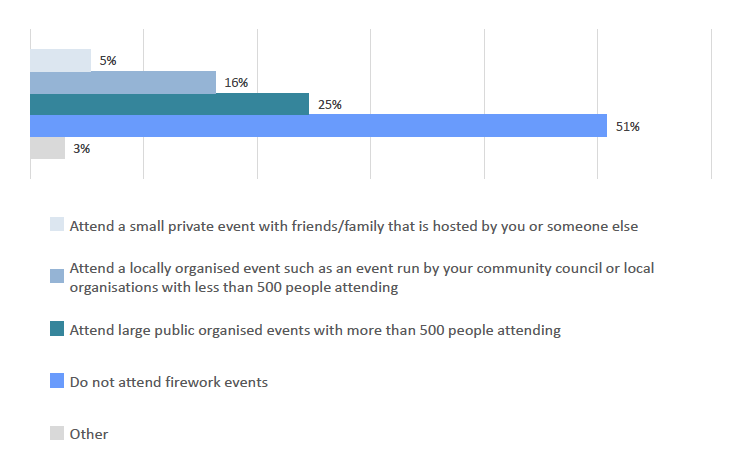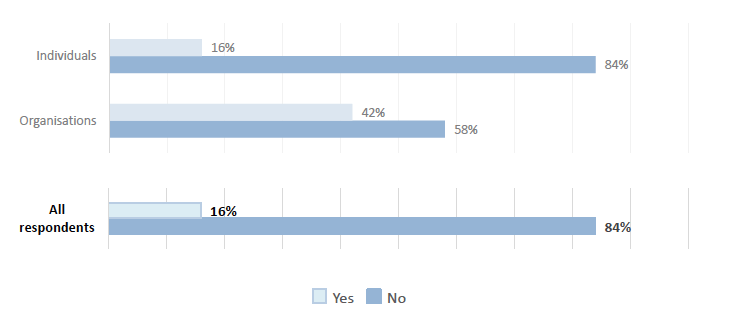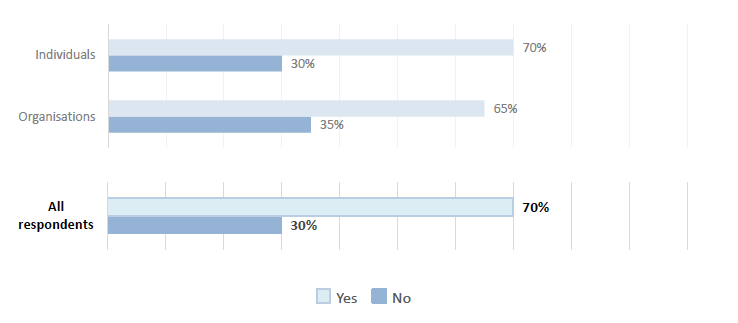Fireworks in Scotland: analysis of responses to consultation
Summary of key themes to emerge from the consultation to gather the public's views on the use and regulation of fireworks in Scotland.
Part One: How are fireworks used in Scotland?
The consultation paper notes that fireworks are often associated with celebration and events that bring communities, friends and families together. These events can be formally organised by the local authority, a local community council or organised community group, but can also be set off in private spaces such as people's back gardens. Some of these celebrations are:
- Diwali
- New Year
- Bonfire night – or "Guy Fawkes night"
- Festival fireworks
- Weddings.
Question 1 - What is the main way you typically enjoy and experience fireworks?
Figure 1: Question 1 - What is the main way you typically enjoy and experience fireworks? (n = 16,274)

Just over half of respondents, 51% of those answering the question, reported that they did not attend fireworks events. Of the remaining respondents, 25% said they attend large public organised events with more than 500 people attending, and 16% a locally organised event with fewer than 500 people attending. Only 5% of respondents said they attend a small private event hosted by themselves or someone else.
Of the 491 respondents who answered 'Other', 487 went on to make a further comment. Most frequently, respondents explained that they do not go to events because they need to stay with pets or that they simply do not like fireworks.
Ways of enjoying fireworks identified included watching displays from their home or garden, only attending professional displays, attending a mix of the types of event set out in the question, or watching firework displays on television.
Question 2 - Would you say that fireworks form an important part of celebration events for you?
A majority of respondents, 84% of those answering the question, said that fireworks do not form an important part of celebrations for them, while 16% said they did. Organisational respondents were more likely than individuals to say that fireworks form an important part of celebration events for them (42% and 16% respectively).
Figure 2: Question 2 - Would you say that fireworks form an important part of celebration events for you? (n = 16,323)

Question 3 - Have you been affected by fireworks being used in an irresponsible or unsafe way?
A majority of respondents, 70% of those answering the question, reported that they had been affected by fireworks used in an irresponsible or unsafe way. The remaining 30% said they had not.
Figure 3: Question 3 - Have you been affected by fireworks being used in an irresponsible or unsafe way? (n = 16,320)

Around 10,940 respondents who said they had been affected went on to provide details, with some of the experiences recounted referring to events from many years ago and others to very recent events.
Impact on pets, livestock and wildlife
Most frequently, respondents commented on the impact on pets, raising concerns or reporting incidents of pets being upset or traumatised as a result of the use/misuse of fireworks. This was very often connected with the more frequent, some said year-round, and apparently random use of fireworks, and with being unable to take measures to protect their pets. A number of animal-related third sector or community group respondents were amongst those raising these issues. For example, an animal-related third sector or community group respondent noted their concerns that fireworks can have a negative impact on the welfare of dogs, including that it is impossible for dog owners to predict or prepare their dogs in advance of fireworks being set off.
Many of the other concerns or reports were also focused on dogs and often noted that, while not all dogs are affected, those that are may experience symptoms ranging from general unease through to extreme distress. The very sensitive nature of dogs' hearing was sometimes highlighted, including because it means dogs can hear fireworks at a much greater distance than humans. A professional or representative body respondent reported that animals have a different hearing range to humans and, as a consequence, many show stress, fear or even phobia responses to loud and high-pitched noises. They went on to note that, while for some animals these fear responses may be transient and decrease as the animal gets used to the noise, a significant proportion will become sensitised and that it is estimated that 45% of dogs show signs of fear when they hear fireworks.
From other respondents, there were reports of their dogs shaking, cowering and hiding, not being able to leave the home (leading to fouling indoors) and being unable to eat. As pet owners, respondents sometimes reported feelings of upset and helplessness when having to watch the effects on their pet and being unable to alleviate those effects:
My little dog is petrified for a month leading up to 5th November, and then the same at Christmas. A usually happy dog she cowers in corners and refuses to go outside. She shakes and is so scared, I have purchased stress relief tablets and sprays, a thunder shirt, but nothing works. It is so upsetting to watch this, and we feel totally helpless...
Individual respondent
Some dog and other pet owners spoke of seeking veterinary advice or treatment, usually in the form of tranquilisers. However, it was noted that while tranquilisers may be used for a short while, the lengthening of the main fireworks season makes this an increasingly impractical option. The costs associated with trying to help their dog or other pet, including by seeking veterinary treatment, were highlighted by some.
In terms of other types of pets that may be particularly distressed by fireworks, respondents spoke of cats, rabbits and birds. There were also reports of horses or ponies becoming distressed by the sound of fireworks, with the challenges associated with protecting an animal which lives primarily out of doors, and potentially at some distance from their owner, highlighted. As with other animals, respondents spoke of horses being traumatised and sometimes injuring themselves. There were a small number of reports of broken limbs or other bones meaning horses had to be euthanised.
There were also reports of dogs and cats injuring themselves or being injured or killed as a result of running onto roads or railway tracks, or of animals dying from heart attacks or extreme stress reactions. Some respondents also noted that they had read or heard about animals being deliberately injured or killed, for example by youths attaching fireworks to their tails.
There were some specific references to support dogs, including guide or hearing dogs, and the adverse impact that fireworks can have on their training and/or their ability to do their work. These included comments from those responsible for their training.
Respondents also commented on the impact that fireworks can have on other animals, including livestock and wildlife. For example, there were reports of sheep and cattle stampeding or injuring themselves, and a small number of respondents who identified themselves as being farmers spoke of occasions where fireworks have impacted negatively on lambing and marketing cycles, meaning financial loss for their business. A Professional or representative body respondent reported that their members have experienced problems with livestock being spooked or injured as a result of fireworks being used irresponsibly and spent fireworks littering grazing land and crops.
When fireworks are being used
Respondents also commented on when fireworks are being used, often (as above) making the connection with the impact on animals and the inability to plan. Respondents spoke of the 'core' fireworks season as no longer being restricted to Bonfire night and the closest weekend, but as extending from Halloween through to New Year and beyond.
For some, the perceived increase in the number of occasions when fireworks are being let off in their community was a source of annoyance or distress. This was sometimes compounded by where and by whom those fireworks were being used:
Every year our area is blighted by youths and young men throwing fireworks in the street and in common back courts at all hours of the day and night. In the worst years this begins in September and continues until January peaking in October/November.
Individual respondent
Concerns were raised about the times of day when fireworks were being let off in their communities, including reports that they are being used during daylight (with possible consequences for the safety of people and animals) and late at night. In the latter case, a number of people spoke of their own or their children's sleep being disturbed, sometimes over prolonged periods. The impact on shift workers of fireworks being let off during the daytime or early hours of the morning was also noted.
While many of the references to animals becoming upset referred to the use of fireworks after dark, there were also a number of reports of dogs being exposed to fireworks being let off during the day and to this being impossible for pet owners to predict and plan for.
Types of fireworks
In addition to the times of day or night at which fireworks were being let off, respondents also commented on the impact of the noise levels and strength of fireworks being used. There was a clear perception that manufacturers are making louder fireworks, and that louder and more powerful fireworks that would once have been confined to organised displays are now easily accessible to the general public.
The impact of higher noise levels, combined with higher frequency of use, was occasionally described as making people feel as if they were living in a war zone. Although noise-related concerns were usually associated with what respondents saw as misuse of fireworks (in terms of being let off in the street, at unpredictable times in back gardens etc), there were also references to noise levels associated with both public, organised displays and displays at private venues/for private events such as weddings.
In terms of references to particular types of fireworks, there were suggestions that bangers have been, or remain, an issue[4] and in particular that they are falling into the hands of young people and children who let them off in the streets.
There were also concerns that some types of fireworks, most especially those that leave debris some distance from where fireworks are let off, are having a serious environmental impact. There were reports of people finding firework litter in their garden or on the roof of their home, in public parks, in the street or on beaches.
Misuse of fireworks, including targeted misuse
As noted above, respondents often highlighted aspects of their lives that are being, or have been, affected by other people's use of fireworks. A community safety organisation respondent reported that they are aware of a significant number of injuries from the use of fireworks in Scotland and that some are caused by irresponsible use.
Respondents often referred to what they considered the antisocial use, misuse or illegal use of fireworks. However, comments suggested that at least some of this activity (for example people letting off fireworks during the evening in their back garden) would fall within current legal parameters governing the use of fireworks. This also applied to many of the comments referring to young people or children misusing (as opposed to purchasing) fireworks. Controls over sale and use of fireworks are discussed further at Questions 4 and 6 in particular.
Other comments did suggest clear misuse and/or possible illegal use, particularly in relation to letting off fireworks in the street, throwing fireworks or deliberately using fireworks in a way that could result in injury to a person or animal, or damage to property. Other respondents referred to witnessing fireworks being thrown, usually by young people, at pedestrians, animals, or passing cars. The connection between such behaviour and being under the influence of alcohol was sometimes made.
Some respondents referred to either being the target, witnessing or hearing about someone being the target of a firework-related incident or attack. These included reports having been a target when simply walking along the road, or in a public space, often with their dog(s). There were also a number of reports of fireworks being thrown at prams, pushchairs and children. For example:
In 2018 my 3 year old daughter and I had a firework thrown at us in the street around the corner from where we live. It nearly blew up in her face and has made her (and myself) terrified of them.
Individual respondent
A number of reports referred to fireworks being thrown at or into cars, and the potential for a very serious accident was sometimes highlighted. More generally, some respondents spoke of either themselves or friends or family members being physically injured; most frequently the references were to burns and/or serious injuries to eyes and faces. An Emergency Service respondent reported that in 2017 a Police Sergeant sustained serious injuries as a result of fireworks being thrown and fired at officers. They noted that, in addition to this, there were a number of incidents where emergency service personnel were deliberately targeted by groups of youths at unauthorised bonfires and elsewhere.
Respondents also highlighted both the potential for damage and actual firework-related damage to property that they had seen. As at other questions, some of the comments made direct reference to the area in which respondents lived and covered a diverse range of primarily urban areas. There were also specific references to recent events in Glasgow:
My wife and I have lived in Pollokshields, Glasgow which every autumn is plagued with problems caused by fireworks misuse. We've witnessed a Mini in flames from a box of fireworks placed underneath the chassis, young people blowing up bins and filming the vandalism on their phones, as well as difficulty walking home from work - essentially running a gauntlet of teenagers aiming fireworks at each other, cars and the public.
Individual respondent
Contact
There is a problem
Thanks for your feedback